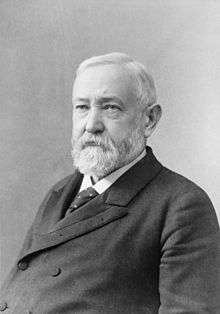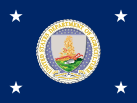Jeremiah McLain Rusk
| Jeremiah McLain Rusk | |
|---|---|
 | |
| 2nd United States Secretary of Agriculture | |
|
In office March 6, 1889 – March 6, 1893 | |
| President |
Benjamin Harrison Grover Cleveland |
| Preceded by | Norman J. Coleman |
| Succeeded by | Julius S. Morton |
| 15th Governor of Wisconsin | |
|
In office January 2, 1882 – January 7, 1889 | |
| Lieutenant |
Sam S. Fifield George W. Ryland |
| Preceded by | William E. Smith |
| Succeeded by | William D. Hoard |
| Member of the U.S. House of Representatives from Wisconsin's 7th district | |
|
In office March 4, 1873 – March 3, 1877 | |
| Preceded by | District Created |
| Succeeded by | Herman L. Humphrey |
| Member of the U.S. House of Representatives from Wisconsin's 6th district | |
|
In office March 4, 1871 – March 3, 1873 | |
| Preceded by | Cadwallader C. Washburn |
| Succeeded by | Philetus Sawyer |
| Personal details | |
| Born |
June 17, 1830 Malta, Ohio |
| Died |
November 21, 1893 (aged 63) Viroqua, Wisconsin |
| Political party | Republican |
| Profession | Politician, Banker, Farmer |
| Military service | |
| Service/branch |
United States Army Union Army |
| Rank |
|
| Unit | 25th Wisconsin Volunteer Infantry Regiment |
| Battles/wars | American Civil War |
Jeremiah McLain Rusk (June 17, 1830 – November 21, 1893) was a U.S. Representative, the 15th Governor of the U.S. state of Wisconsin from 1882 to 1889 and the U.S. Secretary of Agriculture from 1889 to 1893.
Biography

Rusk was born in Malta, Ohio.[1] He was a member of the Republican Party. He began as a planter, then turned to innkeeping and finally to banking before the American Civil War.
Rusk started his service with the Union Army during Civil War as major of the 25th Wisconsin Volunteer Infantry Regiment on August 14, 1862.[2] He was promoted to lieutenant colonel on September 16, 1863.[2] He took command of the regiment on July 22, 1864 when Colonel Milton Montgomery was wounded and captured at Decatur, Georgia during the Battle of Atlanta.[2][3] He continued in command after Montgomery was exchanged because Montgomery was given command of the brigade to which the 25th Wisconsin Infantry was assigned.[2][3] Rusk was wounded at Salkehatchie River, Georgia on January 20, 1865.[2] Rusk was mustered out of the volunteers on June 7, 1865.[2] He received an appointment as brevet colonel to rank from March 13, 1865, preliminary to his appointment as a brevet brigadier general of volunteers.[2] On February 24, 1866, President Andrew Johnson nominated Rusk for appointment to the grade of brevet brigadier general of volunteers to rank from March 13, 1865, and the United States Senate confirmed the appointment on April 10, 1866.[4]
After the Civil War, he became a congressman in the United States House of Representatives.[5] He was elected to the Forty-second United States Congress as the representative of Wisconsin's 6th congressional district serving from March 4, 1871 to March 3, 1873. For the Forty-third Congress he redistricted and was elected as representative of Wisconsin's newly created 7th District. He was reelected to the Forty-fourth Congress as well serving from March 4, 1873 to March 3, 1877. While in congress, he was chairman of Committee on Invalid Pensions (Forty-third congress). After his terms in congress he ran as a Republican for Governor of Wisconsin, an election he won.[5] His most noted act during his governorship was when he sent the National Guard into Milwaukee to keep the peace during the May Day Labor Strikes of 1886. The strikers had shut down every business in the city except the North Chicago Rolling Mills in Bay View. The guardsmen's orders were that, if the strikers were to enter the Mills, they should shoot to kill. But when the captain received the order it had a different meaning: he ordered his men to pick out a man and shoot to kill when the order was given. This led to the Bay View Tragedy, in which a number of workers were killed; Governor Rusk took most of the blame.
In 1889, after the end of his third term as governor, he accepted the new cabinet position of Secretary of Agriculture in the Benjamin Harrison administration.[5] He lived, died and was buried in Viroqua, Wisconsin.[6]
The house he bought and lived in while Governor of Wisconsin, now known as the Old Executive Mansion, was used by the state as the official residence of the Governor for several decades and is listed on the National Register of Historic Places.[7]
See also
References
- ↑ "Rusk, Jeremiah McLain (1830–1893)". Biographical Directory of the United States Congress. United States Congress. Retrieved 20 December 2010.
- 1 2 3 4 5 6 7 Eicher, John H., and David J. Eicher, Civil War High Commands. Stanford: Stanford University Press, 2001. ISBN 0-8047-3641-3. p. 465.
- 1 2 Eicher, 2001, pp. 393–394.
- ↑ Eicher, 2001, p. 756.
- 1 2 3 Spetter, Allan. "Jeremiah M. Rusk (1889–1893): Secretary of Agriculture". American President: An Online Reference Resource. University of Virginia. Retrieved 20 December 2010.
- ↑
- ↑
External links
| Wikimedia Commons has media related to Jeremiah McLain Rusk. |
- United States Congress. "Jeremiah McLain Rusk (id: R000517)". Biographical Directory of the United States Congress. Retrieved on 2008-02-12
- "Jeremiah McLain Rusk". Find a Grave. Retrieved 12 February 2008.
| United States House of Representatives | ||
|---|---|---|
| Preceded by Cadwallader C. Washburn |
Member of the U.S. House of Representatives from Wisconsin's 6th congressional district March 4, 1871 – March 3, 1873 |
Succeeded by Philetus Sawyer |
| Preceded by District Created |
Member of the U.S. House of Representatives from Wisconsin's 7th congressional district March 4, 1873 – March 3, 1877 |
Succeeded by H. L. Humphrey |
| Political offices | ||
| Preceded by William E. Smith |
Governor of Wisconsin 1882 – 1889 |
Succeeded by William D. Hoard |
| Preceded by Norman J. Coleman |
U.S. Secretary of Agriculture Served under: Benjamin Harrison March 6, 1889 – March 6, 1893 |
Succeeded by Julius S. Morton |


